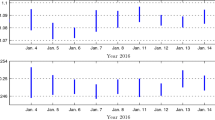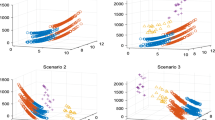Abstract
Stock market forecasting has been a challenging financial research topic for decades. In the literature, there are numerous results based on point methods. However, poor forecasting quality has been a continuous problem. Motivated by the fact that financial data varies within intervals, we apply interval methods on a well known stock pricing model [3] to predict stock market variability as intervals. Empirical results obtained with a few different approaches in this paper consistently suggest that interval forecasts have better overall quality than traditional point forecasts.
Similar content being viewed by others
References
Chatfield C. (1993). Calculating Interval Forecasts. Journal of Business and Economic Statistics 11: 121–144
Chatfield C. (2001). Prediction Intervals for Time-Series Forecasting. In: Armstrong, J.S. (eds) Principles of Forecasting: Handbook for Researchers and Practitioners, pp. Kluwer Academic Publisher, Boston
Chen N., Roll R. and Ross S. (1986). Economic Forces and the Stock Market. Journal of Business 59: 383–403
Fama E. and French K. (1997). Industry Costs of Equity. Journal of Financial Economics 43: 153–193
Gardner E. (1988). A Simple Method of Computing Prediction Intervals for Time Series Forecasts. Management Science 34: 541–546
Gooijer J. and Hyndman R. (2006). 25 Years of Time Series Forecasting. Journal of Forecasting 22: 443–473
Granger C. (1996). Can We Improve the Perceived Quality of Economic Forecasts?. Journal of Applied Econometrics 11: 455–473
He L. (2005). Instability and Predictability of Factor Betas of Industrial Stocks: The Flexible Least Squares Solutions. The Quarterly Review of Economics and Finance 45: 619–640
He, L. and Hu, C.: Impacts of Interval Measurement on Economic Variability Study: Evidence from Stock Market Variability Forecasting, working manuscript, 2007.
He, L. and Hu, C.: The Stock Market Forecasting: An Application of the Interval Measurement and Computation, in: The 2nd Int. Conf. on Fuzzy Sets and Soft Comp. in Economics and Finance, St. Petersburg, Russia, 2006, pp. 13–22.
Hu C., Cardenas A., Hoogendoorn S. and Selpulveda P. (1998). An Interval Polynomial Interpolation Problem and Its Lagrange Solution. Reliable Computing 4(1): 27–38
Hu C., Xu S. and Yang X. (2002). A Review on Interval Computation—Software and Applications. Journal of Computational and Numerical Analysis and Applications 1(2): 149–162
Moler, C.: Numerical Computing with MATLAB, SIAM, 2004.
Moore, R.: Methods and Applications of Interval Analysis, SIAM Studies in Applied Mathematics, 1979.
Neumaier, A.: Interval Methods for Systems of Equations, Cambridge University, 1990
Nooner, M. and Hu, C.: A Computational Environment for Interval Matrices, in: NSF 2006 Workshop on Reliable Engineering Computing, Savannah, GA, 2006, pp. 65–74.
Ross S. (1976). The Arbitrage Theory of Capital Asset Pricing. Journal of Economic Theory 13: 341–360
Author information
Authors and Affiliations
Corresponding author
Rights and permissions
About this article
Cite this article
Hu, C., He, L.T. An Application of Interval Methods to Stock Market Forecasting. Reliable Comput 13, 423–434 (2007). https://doi.org/10.1007/s11155-007-9039-4
Received:
Accepted:
Published:
Issue Date:
DOI: https://doi.org/10.1007/s11155-007-9039-4




